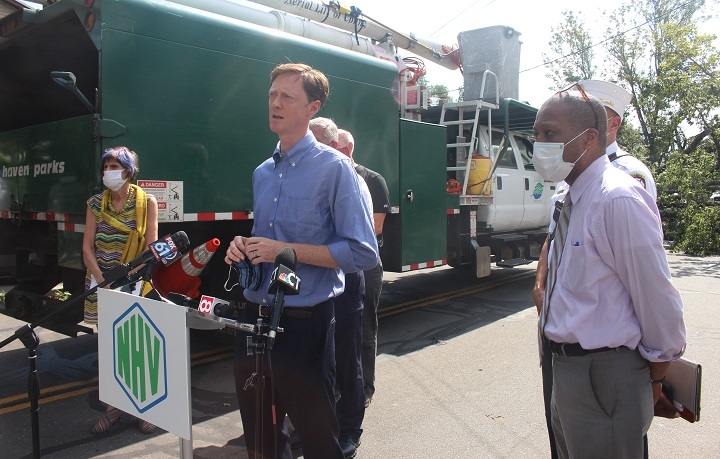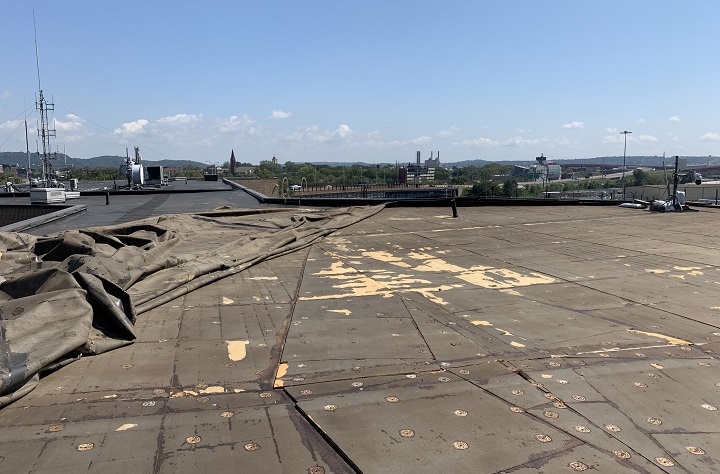
Thomas Breen photos
A toppled tree on Lombard Street. Below: City tree trimmer Adam Wambolt clears the wreckage.


Police headquarters’ servers: Too hot to work.
City officials Wednesday surveyed the widespread damage caused by Tropical Storm Isaias’s 63 mile-per-hour winds — and cautioned that it may take a week or longer for all of the 8,000-plus local homes still without electricity to regain power.
Mayor Justin Elicker and city emergency operations chief Rick Fontana joined city parks and public works department heads as well as a handful of city tree trimmers to give that update on the storm’s wreckage — and the city’s response — during a press conference held at 3:30 p.m. at Lombard Street and Monroe Street in Fair Haven.
An hour earlier, Elicker and City Engineer Giovanni Zinn visited New Haven Police Department headquarters at 1 Union Ave. to gauge the damage done to the building’s roof — as well as the knock-on effects of a busted air conditioner, which led to an overheated server, which led to computer aided dispatch going down, which led to 911 call operators taking notes all on paper and rushing across the room to physically hand those notes to dispatchers. (See more on that below.)
The Fair Haven presser offered a more general overview of the damage wrought by Tropical Storm Isaias in New Haven.
And, appropriately enough, the event took place just a few feet away from a towering Bradford Pear Tree that had been toppled by Tuesday’s tropical storm and that still lay across Lombard Street, obstructing traffic and tugging the adjacent sidewalk up with its roots.

Mayor Justin Elicker (center) at Wednesday’s press conference.
“The kind of impact we’ve seen around the city, the kind of power lines that have been down and trees that have been down, this is going to take quite a long time for us to address,” said Elicker. “This storm was a very, very significant wind event.” He said after the press conference that the recovery will take “many days” at least.
The mayor said that 11,599 New Haven households — or just about 20 percent of the city — were without electricity at around 6 p.m. Tuesday, towards the tail end of a daylong barrage by what Fontana described as a “mega tropical storm.” As of 1:30 p.m. Wednesday, 8,151 local households — or roughly 13 percent of the city — were still without power.
Click here to view a United Illuminating map of current outages in the region.
Elicker said the total number of outages caused by Isaias were more than those caused by Hurricane Sandy and less than those caused by Hurricane Irene. He said those previous natural disasters led to sustained power outages lasting between seven and 10 days at households throughout the city, and warned that Isaias’s timeline could be similar.
Bill Carrone, the acting director of the city’s parks department, said that Tuesday’s storm knocked over roughly 200 trees around the city. Elicker said that the New Haven Fire Department has completed a survey of every street in the city and has found that 128 streets were still partially or completed blocked by fallen trees as of Wednesday afternoon.
Elicker said seven different tree crews — three city crews and four hired contractor crews — are currently out working to remove that blockage.
United Illuminating has two crews out addressing power outages, Elicker said.
And the mayor outlined the three-step process by which UI restores power to families that have lost electricity because of a fallen tree or a downed line.
First, UI send a crew out to turn off the power. “We cannot do anything in regards to tree removals until that happens,” Elicker said.
Second, either a city tree crew or a UI tree crew removes the fallen tree from the power lines.
Third, another UI crew comes back to turn the power on.
Elicker warned that residents may see work done on a line to remove obstructing tree branches but still not see power immediately turned back on.
“This is a three-step process in order to make sure that we’re keeping our residents safe and our tree crews safe,” he said.
He and city public works director Jeff Pescosolido urged residents to bring fallen branches and other tree debris out to the curbside in front of their homes for city crews to pick up as part of the city’s regular trash removal schedule next week.
Elicker also said that the city’s five libraries are open during regular business hours for people to come inside, cool off, and use electrical outlets to charge their phones.

City emergency operations chief Rick Fontana.
Fontana (pictured) said the city will be providing ice to people who do not have power and need to keep medication cool in the interim.
Residents who need ice for medication only, are out of power, or see a tree blocking the public right of way or pulling down power lines should call the city’s Emergency Operations Center at 203 – 946-8221.
Fontana and Assistant Fire Chief Mark Vendetto said that a man in Newhallville suffered severe injuries yesterday when he was walking outside and a toppled tree branch crushed one of his legs. Otherwise, despite the widespread falling of trees throughout the city, there were no other injuries reported Tuesday related to the storm.
Fontana said five people used an emergency refuge area set up at 200 Orange St., but that the city did not have to activate emergency shelters at Career High School, Hillhouse High School, or Wilbur Cross High School.

At the end of the press conference, city tree trimmer Adam Wambolt (pictured) pulled on his helmet and goggles, revved up a chainsaw, and started taking apart the tree lying across Lombard Street.
Carrone estimated it would take only four or five minutes to cut up and remove the tree.
Reflecting on the rush of work all across the city that tree trimmers and parks and public workers staffers like himself have been called on to do in the wake of the tropical storm, Wambolt said, “This is like our Super Bowl.”
Fontana agreed, and commended all of the city workers, from tree trimmers to firefighters to public works staffers and police officers, who hustled — and are still hustling — to bring back a sense of normalcy to the city.
“We worked through the night trying to make areas safe, high impact areas that needed to be traveled,” he said. “This is gonna take some patience. People will be inconvenienced. We apologize for that right now. But we are in this as a team.”
Leaky Roof, Busted ACs, and a 911 Computer Outage At Police HQ

Elicker and Zinn outside police HQ.

Giovanni Zinn photo
The rubber protective sheet atop 1 Union Ave.’s roof, peeled back by the storm to expose masonry.
Earlier Wednesday afternoon, Elicker visited 1 Union Ave. to talk with the city’s engineer about the damage done to the police headquarters’ roof.
Zinn said that, at around 2 p.m. Tuesday, the storm’s winds peeled back roughly one-third of the rubber sheet that covers the police department’s roof. The high-speed winds likely got underneath the metal cap on the roof’s parapet, Zinn said, and peeled the rubber back — leaving the building’s masonry exposed to the open air.
That meant that the rain from Tuesday’s storm caused leaks in the department’s training room as well as in a non-records portion of the records room.
“We did not have any records get wet,” Zinn said. The fire department rushed to the scene and put a tarp over all of the records, protecting those documents for the duration of the storm.
Zinn said that an on-call roofer was working atop 1 Union Ave. at that very moment, pulling back the rubber and applying more rubber. A crane would be coming by at 7 p.m. to bring another roll of rubber material — known as EPDM — that would be stretched across the roof and battened down. “Then probably, we’re going to have to replace the roof,” Zinn said.

Police headquarters’ servers: Too hot to work.
While the rain caused relatively little direct damage to anything in the building’s interior, Zinn said, the storm did knock out both of the server room’s air conditioning units.
With no air conditioning on as Tuesday night turned into Wednesday morning, the server room got hot — upwards of 98 degrees — and led to the servers themselves overheating and turning off automatically as a form of technological self-protection.
This shutting down of the servers in turn led to the shutting down of computer aided dispatch (CAD) for the city’s Public Safety Communications department — that is, the group that takes in 911 calls and then dispatches police officers, firefighters, and ambulances based on the nature and location of each call.

Peet, showing one of the paper slips his staff had to revert to as the computers were down.
In the city’s 911 call center on the fourth floor of 1 Union Ave., Public Safety Communications Director George Peet (pictured) said that the temporary outage of CAD meant that his staffers were working with pencil and paper in a manual process of call in-takes and dispatches. “We’re back to like 1965,” he said.
Here’s how it worked Wednesday morning and afternoon before the servers came back online at around 4 p.m.
A 911 call taker on the fourth floor of 1 Union Ave. would receive an emergency call from a New Haven resident, and then take down notes about that call by hand.
After writing down the name of the caller, their address, and pertinent details about the nature of the call, the call taker would then rush across the room, paper in hand, and give that document to a 911 dispatcher.
The dispatcher would then call by radio to city police or the fire department or American Medical Response ambulance drivers to direct the emergency first responders to the scene.
Peet said that CAD being down on Wednesday had nothing to do with 911 being down in New Haven on Tuesday during the storm itself. That latter issue was caused by a problem with fiber optic cables operated by AT&T and the state, he said. New Haven relied on West Haven’s 911 call takers from around 3:30 p.m. to just after 7 p.m. Tuesday. West Haven operators would receive a 911 call, take down notes, and then call New Haven dispatchers to follow through on the response.
“Yesterday was pretty chaotic,” Peet said. “We were absolutely inundated in calls.”
The calls ranged from medical issues to concerns about downed trees to even a handful about people trapped in cars covered in live power lines.
Once CAD came back online, Peet said, the New Haven 911 operators would have to back-enter all of the call details written down by hand Wednesday into the computer system.

Blowing cool air into the server room.
Down the hallway from the 911 call center, Zinn showed a jerry-rigged set up that ultimately proved successful in cooling down the server room before the air conditioners were replaced.
He and several city staffers used a tarp and three strategically-positioned fans to create a duct pointing from the hallway into the server room.
The fans blew cool air through the duct, and helped bring the temperature of the room to around 90 degrees.

Replacing a busted air conditioner.
A city worker, meanwhile, worked in the room to replace the air conditioners.
Zinn said that, by 4 p.m., one of the air conditioning units had been replaced, was up and running, the servers were back on, and 911 call operators could use their computers again.